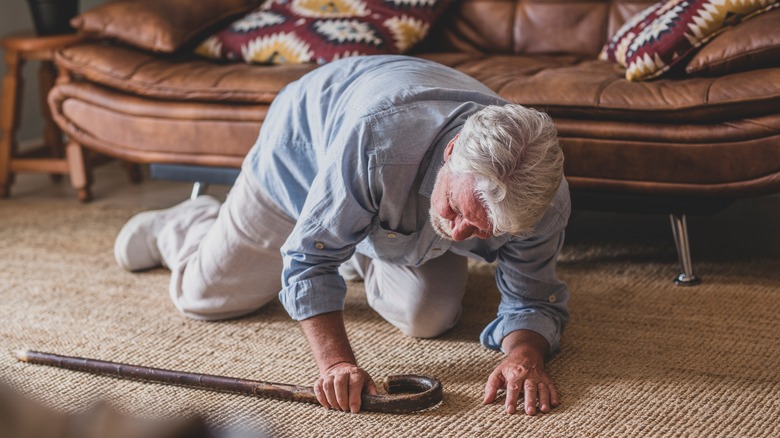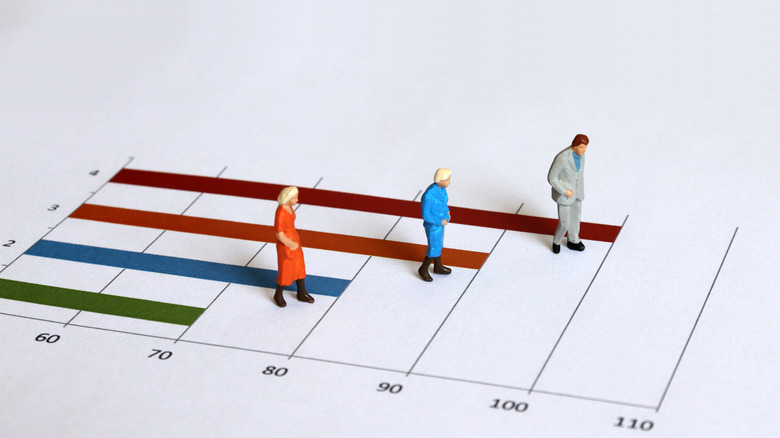Sarcopenia Explained: Causes, Symptoms, And Treatment
While the term for bone loss (osteoporosis) is familiar to most people, the term for muscle loss (sarcopenia) is generally not well known, according to a study published in the Journal of Aging and Health. Sarcopenia is the progressive loss of muscle mass and strength that occurs with advancing age (per the Cleveland Clinic). A decrease in both the number and size of muscle fibers leads to muscle atrophy (shrinking). Since muscles and bones are closely connected, loss of muscle mass and strength increases the risk of frailty, falls and fractures.
While some people with sarcopenia may experience a decline in quality of life and have difficulty performing daily activities, others may become totally dependent and require long-term care.
As noted by Medical News Today, decreasing levels of tissue-building hormones — testosterone, insulin-like growth factor (IGF-1) — in older adults may contribute to sarcopenia. Muscle loss typically begins at "around the age of 40" and progresses at a rate of about 3-8% of muscle mass every decade. Often, an increase in body fat occurs alongside age-related muscle loss, explains the NIH. This is referred to as "sarcopenic obesity" and is associated with insulin resistance, a condition that impairs the synthesis of protein in muscle tissue and drives fat buildup. The combination of resistance exercise and a high protein diet is the best strategy to counter sarcopenia.
Prevalence of sarcopenia
According to a 2017 systematic review of 35 studies published in the Journal of Diabetes and Metabolic Disorders, the overall global prevalence of sarcopenia in both men and women over the age of 60 is 10%. Men over 80 years old had the highest prevalence at a rate of 50%. Compared to non-Asian individuals, Asian populations were found to have a lower prevalence of sarcopenia. This may be due to smaller muscle mass, healthier diet, and more physical activity among Asians. The study authors also note that an expected higher prevalence of sarcopenia occurs in elderly people in rehabilitation units, nursing homes, and hospitals.
Another systematic review of studies published in a 2020 edition of the journal Experimental Gerontology examined the prevalence of sarcopenia coexisting with other diseases. Compared to disease-free individuals, sarcopenia was significantly more prevalent in people with cardiovascular disease, dementia, diabetes, and respiratory disease. Many risk factors for sarcopenia are also common to these diseases, including inactivity, inflammation, and protein-energy malnutrition. When coexisting alongside these serious conditions, sarcopenia may require tailored treatment plans. For example, cardiorespiratory disease and dementia may make it difficult to implement exercise regimens.
Functions of muscle
As explained by the NIH, skeletal muscles are attached to your bones and are under the control of the nervous system. By converting chemical energy into mechanical energy, these voluntary muscles generate force and power, thus enabling all types of movement. Skeletal muscles also store nutrients (e.g., amino acids, carbohydrates in the form of glycogen), stabilize joints, and maintain body posture and body temperature. They make up about 40% of total body weight and account for 50-75% of all the proteins in the body.
According to a 2018 study published in the Journal of Cachexia, Sarcopenia and Muscle, the type of muscle that is lost from sarcopenia is skeletal muscle. Apart from locomotion, skeletal muscles play major roles in metabolic health. For example, muscles are essential for blood sugar control — muscle is the main tissue that takes up and removes excess glucose form the blood. Since muscle is involved in burning fatty acids for energy, impairment of this process could cause fat to accumulate in muscle, potentially leading to insulin resistance, metabolic syndrome, and obesity.
Another function of muscle is to secrete hormones called myokines, continues the study. Myokines exert beneficial effects on other tissues such as the pancreas, bone, liver, and fat tissue. Sarcopenia is primarily associated with a substantial decrease in the size of type II muscle fibers (versus type I fibers). Type II muscle fibers are mainly engaged in high intensity exercises that cause rapid fatigue — e.g., resistance training. Thus, resistance exercises are integral for combatting sarcopenia.
Causes of sarcopenia
The causes of sarcopenia are the same factors associated with aging in general, reports the NIH. These factors include a decrease in the amount and size of type II muscle fibers, inactivity, obesity, insulin resistance, reduced concentrations of anabolic hormones and growth factors, and insufficient protein consumption. As explained by a 2021 review of studies published in Frontiers in Nutrition, an age-related desensitization of muscle tissue to triggers of muscle protein synthesis (e.g., protein, resistance exercise, insulin) may be the primary driver of sarcopenia.
This blunted ability of muscle to make protein is referred to as anabolic resistance. Prolonged periods and brief intervals (as little as seven days) of muscle disuse (e.g., bedrest due to injury or illness) can also cause anabolic resistance, even in young adults (hence the adage "use it or lose it"). The best strategy for older adults to overcome anabolic resistance is to increase both protein consumption and exercise, particularly some form of strength training. Resistance exercise dramatically restores the sensitivity of older muscle to dietary protein.
Other factors that may contribute to sarcopenia include protein-calorie undernutrition and the loss of nerve cells that mediate signaling from the brain to the muscles, notes WebMD. In addition, as described in a study published in a 2018 edition of the Journal of Cachexia, Sarcopenia and Muscle, fat inserted within muscle occurs to a greater extent in older adults. The accumulation of fat in muscle tissue promotes inflammation which in turn decreases skeletal muscle mass and physical performance while also contributing to the development of anabolic resistance.
Risk factors for sarcopenia
According to a 2020 study published in Scientific Reports – on community-dwelling older adults over age 60 — increasing age was the most significant risk factor for sarcopenia. While 6.5% of the participants aged 60 to 69 had sarcopenia, this number more than doubled in the 70 to 79 age group, and increased to nearly 47% in subjects over 80 years old. A low level of physical activity is another major risk factor for sarcopenia.
The study found physical activity that burns less than 400 calories per day was linked to sarcopenia. This translates to two hours a day of moderate physical activity such as household chores, cycling, and gardening. Malnutrition is the third major sarcopenia risk factor, according to a 2020 review of studies published in the journal Nutrients. Inadequate dietary protein and low vitamin D levels were associated with decreased muscle strength.
Moreover, beyond just protein, the overall diet of older adults tends to be poor. Older people eat less food, and the quality of the food is substandard. A 25% reduction in food consumption has been reported among older adults. Chronic inflammation is another contributing risk factor for age-related muscle loss. Systemic inflammation increases with age and triggers the production of reactive free radicals which, when in excess, can cause degeneration of tissues including muscle tissue. Per the review, other risk factors for sarcopenia include low birth weight, disruption of the circadian rhythms, and genetic predisposition.
Smoking and small body size (BMI) are additional risk factors that promote the development of sarcopenia (via a 2021 study in the journal Medicine). Several chronic diseases (e.g., obesity, diabetes) increase the likelihood of muscle loss as well, reports the Cleveland Clinic.
Signs and symptoms of sarcopenia
As described by Medical News Today, the symptoms of sarcopenia are generally determined by the extent of muscle loss. A high degree of muscle loss can lead to overall weakness, poor balance, and low endurance. As a consequence, the risk of falls and fractures is increased and engagement in physical activity is limited. Less exercise results in further muscle loss which, over time, contributes to greater dependence and diminished quality of life.
In a 2016 study published in the Journal of Cachexia, Sarcopenia and Muscle, a self-report questionnaire was evaluated as a means of screening people for sarcopenia based on the detection of early signs and symptoms. The screening questionnaire was designed to identify persons with signs of muscle weakness who are at high risk for adverse outcomes so that early treatment (in the form of resistance exercise) and higher protein intake could be initiated. Low scores on several tests of physical performance correlated with poor muscle function and higher risk for sarcopenia. These tests included strength (ability to lift or carry 10 pounds), assistance walking, rising from a chair, and climbing stairs. The number of falls over a year was also included as part of the screening tool.
Diagnosis of sarcopenia
As noted in a 2016 study in the Journal of Cachexia, Sarcopenia and Muscle, it was in 2016 that sarcopenia was recognized as a disease and given a specific diagnosis code. A consensus of the European Working Group on Sarcopenia in Older People has established a pathway for screening and diagnosing sarcopenia that begins with the use of a questionnaire which screens for self-reported signs of sarcopenia, according to guidelines published in a 2019 edition of Age and Ageing. This is followed by assessment of muscle strength using the handgrip test and the chair stand test which counts the number of times a person can stand and sit from a chair over 30 seconds. Typically, a DXA (Dual-energy X-ray absorptiometry) scan is used to confirm sarcopenia by measuring body composition including muscle mass.
Lastly, the severity of sarcopenia is determined by assessing physical performance via various tests that include gait speed and the 400-meter walk test in which a person tries to walk 20 laps of 20 meters each, as fast as possible, with a maximum of two rest stops permitted during the test.
A 2020 review in the journal Experimental Gerontology stresses the critical importance of screening and diagnosing sarcopenia because it frequently coexists with several other age-related diseases such as cardiovascular disease, respiratory disease, dementia, and diabetes.
Resistance training and sarcopenia
As described in a 2022 study published in the journal Age and Ageing, resistance training — also known as weight training or strength training — is first and foremost among treatment strategies for sarcopenia. Resistance training is exercise in which muscles contract against a resistance force or weight and is performed with free weights, gym machines, bodyweight, kettlebells, or resistance bands. By participating in resistance training, middle-aged and older adults can increase muscle strength and muscle size as well as physical functioning.
An effective and appropriate dose of resistance exercise is critical to maximize its muscle and performance enhancing effects. The recommended prescription consists of two training sessions per week that work the muscles of both the upper and lower-body. The exercises should be executed with a relatively high degree of effort for 1-3 sets of 6-12 repetitions, and at least 48 hours of rest between sessions.
A comprehensive review published in a 2021 edition of The Journal of Nutrition notes that greater muscle gains are achieved in older (and younger) adults when resistance training is combined with sufficient dietary protein (particularly high-quality animal protein), compared with resistance training alone.
Diet and sarcopenia
Along with resistance exercise, the other major treatment strategy for sarcopenia is adequate protein intake (via a 2018 review published in the journal Clinical Nutrition). The loss of muscle mass and strength is associated with low protein intake among older adults. To build new muscle and maintain a net protein balance, muscle tissue requires amino acids from dietary protein to serve as building blocks.
Amino acids also function as signals to directly trigger muscle protein synthesis. Resistance exercise and dietary protein have a synergistic effect because exercise sensitizes muscle to the anabolic effects of amino acids. As explained in a 2019 study in Frontiers in Nutrition, muscle gains (hypertrophy) can only be attained through the synergistic effects of resistance exercise and amino acids (protein), when performed and consumed over time, respectively.
According to a 2013 position paper from an international panel of experts published in the Journal of the American Medical Directors Association, older people require more dietary protein than younger people to maintain muscle mass and drive muscle growth. A protein intake of 1.0 to 1.2 grams per kilogram of body weight per day (or roughly 0.5 grams per pound of body weight per day) is recommended for older adults.
This is a significant increase over the RDA for protein of 0.8 g/kg BW/day. The greater need for protein among older people is primarily due to insufficient protein intake (e.g., loss of appetite, gut issues) as well as anabolic resistance (blunted response to muscle-building signals from protein, insulin, and exercise). Supplementation of 20 grams of protein within the first three hours following exercise sessions is also advised.
Medical treatment of sarcopenia
While currently there are no FDA-approved medications for sarcopenia, several drugs are under investigation, reports a 2019 study published in the journal Annals of Geriatric Medicine and Research. It is well-established that exercise is the most potent therapy for muscle loss; however, many people with sarcopenia have physical limitations that restrict their ability to participate in exercise programs.
Therefore, researchers are investigating the potential of "exercise pills" to treat sarcopenia by mimicking the effects of exercise. For example, by activating the same cellular receptor associated with an enzyme that enables fat burning (AMPK), the drug AICAR "enhanced running endurance by 44% even in sedentary mice" (via Annals of Geriatric Medicine and Research). Likewise, the widely used diabetic drug metformin was shown to improve physical performance.
In addition to exercise mimetics, continues the 2019 study, several hormones with anabolic properties have been demonstrated to increase lean body mass (which includes muscle) in older individuals. Some natural compounds also have potential for use as anti-sarcopenia agents. Ursolic acid (found in apples) reduced muscle loss and triggered muscle growth in mice while tomatidine (derived from unripe green tomatoes) fed to "old mice" markedly decreased age-related deficiencies in muscle mass, strength, and quality. Furthermore, as reported in a 2018 study in Clinical Nutrition, supplementation with vitamin D and omega-3 fatty acids may enhance muscle gains in older adults.
Unlike most myokines, myostatin inhibits muscle growth and may thus promote the development of sarcopenia (via the Mayo Clinic). Suppressing myostatin has been shown to increase muscle mass in adult and older mammals. Accordingly, scientists are investigating the use of various molecules (e.g., antibodies) to inhibit the activity of myostatin and thus help to counter sarcopenia.
Complications of sarcopenia
According to a 2019 systematic review published in the Journal of Cachexia, Sarcopenia and Muscle, people with sarcopenia have a considerably higher risk of falls and fractures than individuals without sarcopenia. Falls can result in physical disability, loss of independence, inability to perform basic tasks, institutionalization, illness, and premature death. Since sarcopenia is a modifiable risk factor for falls, the expedient diagnosis and treatment of sarcopenia is of the utmost importance. Per the NIH, sarcopenia is associated with an increased risk of hospital-acquired infections in elderly patients.
Sarcopenia also increases the risk of dying in patients with end-stage kidney disease, pancreatic cancer, and chronic heart failure. A higher risk of mortality among patients undergoing general surgery and colorectal surgery is associated with sarcopenia as well.
Sarcopenia is a major risk factor for complications of COVID-19, reports a 2021 study published in the journal BioMed. Chronic systemic inflammation, oxidative (free radical) damage, malnutrition, frailty, and other deleterious effects associated with sarcopenia increase vulnerability to COVID-19. Multiple studies have indicated that Covid-19 patients with sarcopenia have an unfavorable prognosis and high death toll.
Prognosis of sarcopenia
The prognosis of sarcopenia is dependent on an individual's age, health, and lifestyle, notes the Cleveland Clinic. Sarcopenia is a progressive condition that, if untreated, can continue to diminish muscle mass and strength to the point of full-time dependency. Fortunately, implementing lifestyle changes (e.g., resistance training and high protein consumption) can slow and even reverse muscle loss.
Per the NIH, important factors that impact the outlook for sarcopenia include falls, fractures, and comorbidities (coexistence of other conditions). Sarcopenia is associated with poor prognosis in some medical disorders as well as major surgery. The prevalence of sarcopenia will increase as the world population ages and as life expectancy improves (via a 2014 study published in the Archives of Public Health).
Data from the World Health Organization (WHO) indicate that the number of people over the age of 65, which is currently 600 million, will exceed 2 billion by 2050. Public campaigns aimed at minimizing the occurrence of this important muscle-wasting condition are warranted.












